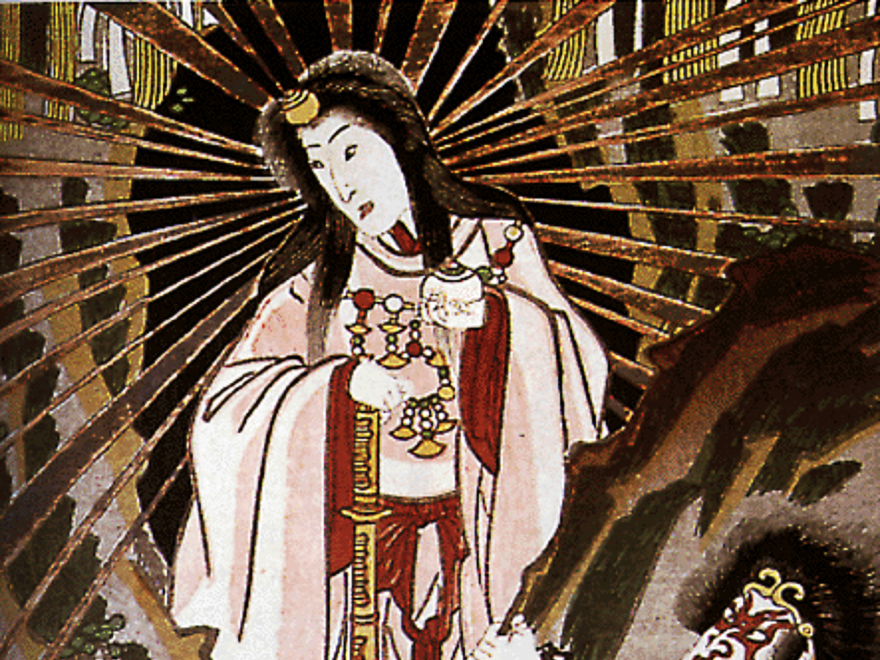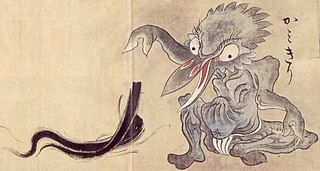
Otters are carnivorous mammals in the subfamily Lutrinae. The 13 extant otter species are all semiaquatic, aquatic or marine, with diets based on fish and invertebrates. Lutrinae is a branch of the Mustelidae family, which also includes weasels, badgers, honey badgers, martens, minks, polecats, and wolverines.

Yōkai are a class of supernatural monsters, spirits, and demons in Japanese folklore. The word yōkai is made up of the kanji for "bewitching; attractive; calamity" and "spectre; apparition; mystery; suspicious." They can also be called ayakashi (あやかし), mononoke (物の怪) or mamono (魔物). Yōkai range diversely from the malevolent to the mischievous, or occasionally bring good fortune to those who encounter them.

A kappa—also known as kawatarō, komahiki, kawatora or suiko–is an amphibious yōkai demon or imp found in traditional Japanese folklore. They are typically depicted as green, human-like beings with webbed hands and feet and a turtle-like carapace on their backs. A depression on its head, called its "dish" (sara), retains water, and if this is damaged or its liquid is lost, the kappa is severely weakened.

The Bell X-9 Shrike was a prototype surface-to-air, liquid-fueled guided missile designed by Bell Aircraft as a testbed for the nuclear-armed GAM-63 RASCAL. It is named after the bird shrike.

不敗の戀人 is an album by Taiwanese singer/actress/model Vivian Hsu, released on 18 October 1999 via the BMG label. Vivian's older sister Penny sang backup on some of the tracks, and later married the producer of this album.

The McDonnell ADM-20 Quail was a subsonic, jet powered, air-launched decoy cruise missile built by McDonnell Aircraft Corporation. The Quail was designed to be launched by the Boeing B-52 Stratofortress strategic bomber and its original United States Air Force designation was GAM-72.

The Circle is the fourteenth studio album by the Japanese rock duo B'z, released on April 6, 2005.

The bakeneko is a type of Japanese yōkai, or supernatural creature. It is often confused with the nekomata, another cat-like yōkai. The distinction between them is often ambiguous, but the largest difference is that the Nekomata has two tails, while the Bakeneko has only one.

Ameonna is a Japanese yōkai thought to call forth rain, illustrated in Toriyama Sekien's Konjaku Hyakki Shūi as a woman standing in the rain and licking her hand.. Women whose actions appear to be calling forth rain are also called this.

Princess Resurrection is a Japanese manga series written and illustrated by Yasunori Mitsunaga. The manga was serialized in Monthly Shōnen Sirius magazine and published by Kodansha. A 26-episode anime series by Madhouse aired on TBS in 2007. Both the manga and anime are available in North America with the manga licensed by Del Rey Manga and the anime licensed by Sentai Filmworks and available on the Anime Network website. A new OVA series has been made by Tatsunoko Production with the first episode released in December 2010, along with the 13th volume of the manga, the second episode for the 14th volume, and the third episode for the 16th volume. A spin-off manga, Naqua-Den, which stars a side character from Princess Resurrection as the main character, was released in 2012 currently with two volumes. On November 25, 2017, a new manga, titled Princess Resurrection Nightmare, was released, though it hasn't been specified whether or not it is a sequel or a parallel world.

1st GAM: Amai Yuwaku is the first studio album of Hello! Project duo GAM, released on May 23, 2007. It contains GAM's first three singles and a remix of their first single "Thanks!".

The Unbelievable is a Hong Kong TV program about paranormal and other supernatural occurrences mostly in Hong Kong and nearby East Asia countries. It is generally based on Eastern Buddhist, Taoist or Chinese spiritual supernatural perspective, though not limited to these philosophies.
NOW is the fourth studio album from the band Girugämesh, released on December 16, 2009 in Japan, January 4, 2010 in the United States and on February 12 in Europe. Three editions of the album were released: a Regular Version CD, a Limited Version CD+DVD, and a Super Limited Version CD+DVD which includes the music videos for "Alive [PV]" and "Border [PV]", G-TRAVEL Footage, a documentary, and an interview about the album.

Your Side is Taiwanese Mandopop artist Stanley Huang's debut Mandarin solo studio album. It was released on 1 March 2000 by EMI Music Taiwan.
Misaki are a collective term for spirit-like existences in Japan like gods, demons and spirits, among other supernatural entities. Their name comes from a kannushi's vanguard.

Tenome is a Japanese yōkai that appeared in the Gazu Hyakki Yagyō by Toriyama Sekien.

Yo-kai Watch is a mixed-media franchise of role-playing video games and toys, created and developed by Level-5. The first game in the series was released for the Nintendo 3DS in 2013. 3 main sequels and several spinoffs, on both Nintendo and mobile platforms, have been released. In December 2019, they expanded to PlayStation.
Bone collecting is a burial ritual practiced in certain parts of East Asia. Peoples known to adopt some forms of this custom include Cantonese, Hoklo, Taiwanese, Ryukyuan, and Zhuang. Most of these groups are related to Baiyue, and indeed ancient Han Chinese had literature that documented such customs being practiced by various Baiyue tribes.

The Monster Building is a system of five interconnected buildings in Quarry Bay, Hong Kong. It is a popular location for photography, and had been used as inspiration for several filming locations.

kamikiri or kurokamikiri is a Japanese yōkai said to secretly cut people's hair on the head. They were rumored from time to time in the urban areas of the Edo Period, and can sporadically seen in the records from the 17th to the 19th centuries.

















